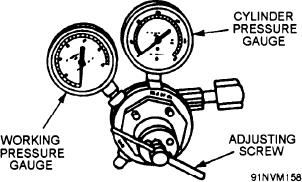
However, a MAPP gas leak is easy to detect and can be
225-cubic foot acetylene cylinder, is 120 pounds (54.0
repaired before it becomes dangerous.
kg) when full.
MAPP toxicity is rated "very slight," but high
MAPP cylinders contain only liquid fuel. There is
concentrations (5,000 ppm) may have an anesthetic
no cylinder packing of acetone to impair fuel with-
effect. Local eye or skin contact with MAPP gas vapor
drawal. For heavy-use situations, a MAPP cylinder
causes no adverse effect. However, the liquid fuel will
will deliver more than twice as much gas as an acety-
cause dangerous frostlike burns due to the temperature
lene cylinder and for longer periods of time. The entire
at which MAPP gas must be stored.
contents of a MAPP cylinder can be used, as there is
no acetone that could be drawn into the regulators or
OXYGEN
torch. As the gas bums with oxygen, it produces a
flame temperature of 5300F (2950C) and will equal
Oxygen is a colorless, tasteless, odorless gas that is
or exceed the performance of acetylene for cutting,
slightly heavier than air. Oxygen will not bum by itself,
heating, and brazing due to its superior heat transfer
but it will support combustion when combined with
characteristics.
other gases. Extreme care must be taken to ensure that
compressed oxygen does not become contaminated with
MAPP is nonsensitive to shock and nonflammable
hydrogen or hydrocarbon gases or liquids, unless the
in the absence of oxygen. There is no chance of an
oxygen is controlled by such means as the mixing cham-
explosion if a cylinder is bumped, jarred, or dropped.
ber of a torch. A highly explosive mixture will be formed
The cylinders may be stored or transported in any
if uncontrolled compressed oxygen becomes contami-
position with no danger of an explosive air pocket
nated. Oxygen should NEVER come in contact with oil
being formed.
or grease.
The characteristic odor, while harmless, gives
Oxygen cylinders are supplied in several sizes.
warnings of fuel leaks in the equipment long before a
The size most commonly used aboard ship is 9 1/8
dangerous condition can occur.
inches in diameter, weighs about 145 pounds, and has
a capacity of 200 cubic feet. At 70F, the gas is under
MAPP gas is not restricted to a maximum working
a pressure of 1800 psi.
pressure of 15 psig, as is acetylene. In jobs requiring
higher pressures and gas flows, MAPP at the full
REGULATORS
cylinder pressure of 95 psig at 70F (21 C) can be used
safely.
The gas pressure in a cylinder must be reduced to a
suitable working pressure before it can be used. This is
MAPP Gas Safety
done by a regulator or reducing valve. Regulators are
either the single-stage or the double-stage type. Single-
Liquified MAPP gas is insensitive to shock. A
stage regulators reduce the pressure of the gas in one
MAPP gas cylinder will not detonate when dented,
step; two-stage regulators do the same job in two steps
dropped, hammered, or even incinerated. It may also
or stages. Less adjustment is generally necessary when
be safely used up to full cylinder pressures. The gas
two-stage regulators are used.
vapors, up to 419F and 285 psig, will not decompose
Figure 8-4 shows a typical single-stage regulator.
when subjected to an energy source in the absence of
The regulator mechanism consists of a nozzle through
oxygen. The vapor also is stable up to 600F and 1,100
psig when exposed to an 825F probe. The explosive
limits of MAPP gas are 3.4 percent to 10.8 percent in
air, or 2.5 percent to 80 percent in oxygen. As you can
see, these limits are very narrow in comparison with
that of acetylene.
MAPP gas has a highly detectable odor. The smell
is detectable at 100 ppm, or at a concentration 1/340th
of its lower explosive limit.
Small fuel-gas systems may leak 1 or 1 1/2 pounds
of fuel or more in an 8-hour shift. Fuel-gas leaks are
often difficult to find, and many times go unnoticed.
Figure 8-4.--Single-stage regulator.
8-3

